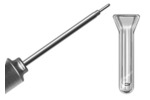- ▶
- Heaters/Source
- ▶
- Agilent Heaters and SensorsMass Spectrometry, Scientific Supplies & ManufacturingScientific Instrument Services 5973 Source Heater Tamper Resistant Allen Wrench 5973/5975 Quad Sensor 5985 Source Heater Assembly Agilent Interface Heater Assembly 5971 Interface Heater

- ▶
- Reference Material on InstrumentationArticle - A High Temperature Direct Probe for a Mass Spectrometer Design of a Direct Exposure Probe and Controller for use ona Hewlett-Packard 5989 Mass Spectrometer SIS AP1000 AutoProbe™ SIS AP2000 AutoProbe™ - Description of System HPP7: Direct Probe Electronics Console HPP7: Direct Probe for the Agilent (HP) 5973/5975 MSD HPP7: HP Direct Probe Application Notes HPP7: Installation Directions for the Direct Probe HPP7: Side Cover for the HP 5973 MSD HPP7: Support HPP7: Probe Inlet System for the Agilent (HP) 5973 and 5975 MSD with Automatic Indexed Stops HPP7: Theory of Operation of the Direct Probe and Probe Inlet System Direct Thermal Extraction Thermal Desorption Application Notes Environmental Thermal Desorption Application Notes Food Science Thermal Desorption Application Notes Forensic Thermal Desorption Application Notes GC Cryo-Trap Application Notes Headspace Application Notes Purge & Trap Thermal Desorption Application Notes Theory of Operation of the AutoDesorb® System AutoDesorb Notes for SIS Dealers Adsorbent Resin Application Notes Installation of the Short Path Thermal Desorption System on Agilent (HP) and Other GCs Installation of the Short Path Thermal Desorption System on a Varian 3400 GC AutoDesorb® System Development Team Thermal Desorption Applications and Reference Materials Installation of the Short Path Thermal Desorption System - TD5 Part I - Design & Operation of the Short Path ThermalDesorption System Installation Instructions for the Model 951 GC Cryo-Trap on the HP 5890 Series GC Installation Instructions for the Model 961 GC Cryo-Trap on the HP 5890 Series GC Operation of the Model 951/961 GC Cryo-Trap SIS GC Cryo Traps - Theory of Operation NIST/EPA/NIH Mass Spectral Enhancements - 1998 version (NIST98) SIMION 3D Ion Optics Class Mass Spectrometer Source Cleaning Methods MS Tip: Mass Spectrometer Source Cleaning Procedures Mass Spec Source Cleaning Procedures Micro-Mesh® Abrasive Sheets Research Papers Using New Era Syringe Pump Systems EI Positive Ion Spectra for Perfluorokerosene (PFK) Cap Liner Information How do I convert between fluid oz and milliliters? Which bottle material should I choose? Which bottle mouth should I choose? The Bottle Selection Guide CGA Connections for Gas Tanks Chemical Reaction Interface Mass Spectrometry (CRIMS)

- Probes
- LiteratureApplication Notes Adsorbent Resins Guide Mass Spec Tips SDS Sheets FAQ MS Calibration Compound Spectra Manuals MS Links/Labs/ Organizations MS Online Tools Flyers on Products/Services Scientific Supplies Catalog About Us NextAdvance Bullet Blender® Homogenizer Protocols Micro-Mesh® Literature Instrumentation Literature Agilent GC/MS Literature SIS News / E-Mail Newsletter NIST MS Database - Update Notifications

- ▶
- HPP7: HP Direct Probe Application NotesNo. 1 - Design of a Direct Exposure Probe and Controller for use on a Hewlett-Packard 5989 Mass Spectrometer No. 2 - A High Temperature Direct Probe for a Mass Spectrometer No. 44 - The Design of a New Direct Probe Inlet for a Mass Spectrometer No. 48 - Demonstration of Sensitivity Levels of Caffeine for a New Direct Probe and Inlet for the HP 5973 MSD No. 49 - Analysis of Cocaine Utilizing a New Direct Insertion Probe on a Hewlett Packard 5973 MSD No. 50 - The Analysis of Multiple Component Drug Samples Using a Direct Probe Interfaced to the HP 5973 MSD
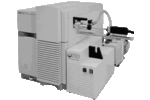
- ▶
- Design of a Direct Exposure Probe and Controller for use ona Hewlett-Packard 5989 Mass Spectrometer (This Page)
Thermal Desorption System Problem Solving - June 1994
by Christopher Baker and John J. Manura,
Scientific Instrument Services, Inc.,
Presented at the 1994 ASMS Meeting, Chicago, IL. JUNE 1994
Introduction
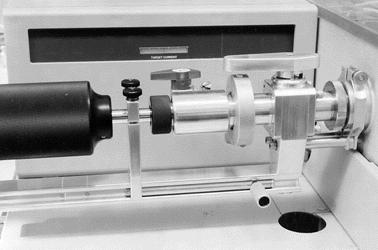 The most common method for the direct introduction of samples
into a mass spectrometer is routinely accomplished with the use
of a direct insertion probe (DIP). This technique is rapid and
easy to use but it has maximum temperature limitations as well
as temperature ramp rate limitations. The DIP design relies on
the transfer of heat from a heating element through the glass
wall of the sample vial to volatilize the sample. This probe has
a maximum temperature of 350 degrees C and a maximum ramp rate
of 50 degrees C/min on the H.P. Engine mass spectrometer. This
article describes a new direct exposure probe (DEP) and controller
which were designed for use on the HP5989 instrument to expand
the range of compounds that can be analyzed via the mass spec
probe. The DEP probe tip consists of a small heater wire onto
which the sample is directly loaded. The DEP wire can be heated
almost instantaneously as well as under controlled ramp rates
to temperatures from room temperature up to pyrolysis temperatures
(> 1200 degrees C).
The most common method for the direct introduction of samples
into a mass spectrometer is routinely accomplished with the use
of a direct insertion probe (DIP). This technique is rapid and
easy to use but it has maximum temperature limitations as well
as temperature ramp rate limitations. The DIP design relies on
the transfer of heat from a heating element through the glass
wall of the sample vial to volatilize the sample. This probe has
a maximum temperature of 350 degrees C and a maximum ramp rate
of 50 degrees C/min on the H.P. Engine mass spectrometer. This
article describes a new direct exposure probe (DEP) and controller
which were designed for use on the HP5989 instrument to expand
the range of compounds that can be analyzed via the mass spec
probe. The DEP probe tip consists of a small heater wire onto
which the sample is directly loaded. The DEP wire can be heated
almost instantaneously as well as under controlled ramp rates
to temperatures from room temperature up to pyrolysis temperatures
(> 1200 degrees C).
Probe Design
A drawing of the DEP probe is shown in Figure 1. It can be seen that the probe tip consists of a plug in connector with a replaceable filament wire for holding and heating of the sample. A glass sample vial is not used in this technique. The sample is dissolved in a solvent, such as methanol, and a drop is placed directly on the filament wire. A current is passed through the filament to directly heat the sample and volatilize it into the mass spectrometer source. Temperatures of over 1200 degrees C can be attained ballistically with this design. This rapid heating can minimize thermal decomposition of some samples as well as vaporize samples quickly into the mass spectrometer to increase the sensitivity of sample analysis. In this technique the actual temperature of the sample is not monitored but it can be varied and controlled through changing of the current levels passed through the filament. A current controller was developed which controls the amount of current passed through the filament from 0.01 amps up to 3.00 amps. It can be programmed to ramp the current through the filament as a function of time at rates from 0.01 amp per minute up to 5.0 amps per minute. No modifications of the HP5989 mass spectrometer were required to utilize the new DEP probe.

Figure 1 - The DEP Probe


Experimental
All experiments were carried out on a Hewlett-Packard 5989A mass spectrometer in the chemical ionization (CI) positive ion mode of operation. The CI reagent gas utilized was isobutane at a source pressure of 0.9 torr. Sucrose and Fructose, along with the pesticide Avermectin were analyzed to demonstrate the usefulness of the probe. Two different styles of filament tips were studied. Due to the plug in style of tips for the DEP probe many other modifications of probe tip design are possible. A rhenium ribbon filament and a glass encapsulated rhenium wire filament were used for these analyses. These two filament tips are shown in Figure 1. These two filament designs were ramped at various rates to determine the effect of both the filament design and ramp rates on the analysis.
Results
Figure 2 shows the separate DEP analyses of Fructose and Sucrose utilizing the rhenium ribbon style DEP filament. The sugar samples were dissolved in Methanol at a concentration of 1.0 ug per ul of solvent and 1.0 ul of this solution was introduced to the center of the rhenium ribbon filament. After the samples were placed onto the rhenium ribbon filament and inserted into the mass spectrometer source, the DEP filament current was ramped from 0 to 1.3 amps at 1.0 amps/min. I t can be seen from the total ion profile that the samples come off in a narrow band but at different times. Although the mass spectra of both sugars are near identical, they can be separated by their ease of volatilization into the mass spec source. This is verified in Figure 3 which demonstrated a total ion profile and mass spectral analysis of a mixture of both sucrose and fructose. The conditions are the same as those of the separate analyses of these two compounds. The ramping of the probe allows the separation of these two compounds and their identification.
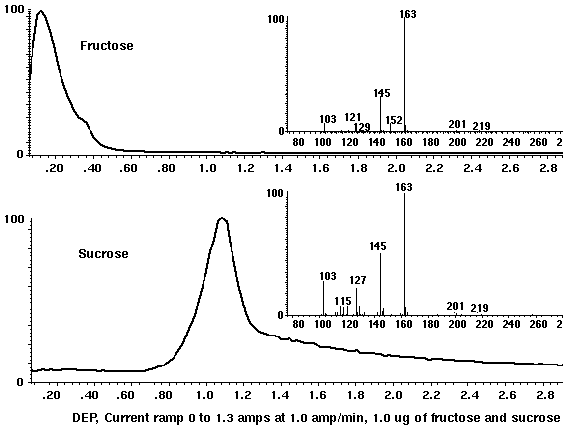
Figure 2 - DEP Analysis of Fructose and Sucrose
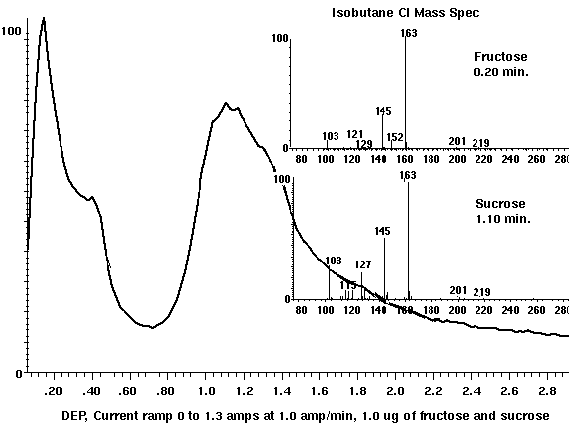
Figure 3 - DEP Analysis of Mixture of Fructose and Sucose
The comparison of the various ramp rates on the analysis of sucrose on the rhenium ribbon style DEP filament is shown in Figure 4. The fastest ramp rate (3.0 amps/min.) provides the sharpest ion profile and also the greatest sensitivity since the analyte is vaporized into the mass spec source in a shorter period of time. When the ramp rate is slowed to 1.0 amp/min. the profile becomes very broad and less sensitivity for the analyte is achieved due to the introduction of the same amount of sugar into the source over a longer period of time. This corresponds to the GC analysis of a sample, in which the highest sensitivity is achieved by optimizing the resolution or peak width of the analyte of interest. Figure 5 shows the same set of experiments except that the DEP filament is a glass encapsulated rhenium wire. The sucrose comes off earlier from the glass encapsulated wire than from the rhenium ribbon. Slowing the ramp rate of the analysis has the same effect of widening the ion profile and loss of sensitivity as for the rhenium ribbon style filament.
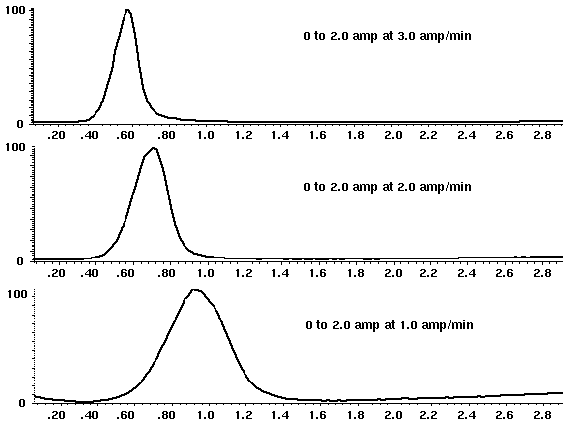
Figure 4 - Comparison of Ramp Rates
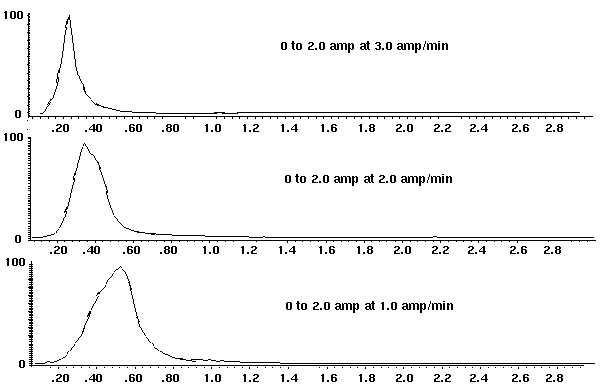
Figure 5 - Comparison of Ramp Rates
The analysis of a high molecular weight pesticide via the DEP probe technique is shown in Figure #6. The pesticide Avermectin was analyzed using the glass encapsulated rhenium wire filament at a ramp rate of 2.0 amps per minute from 0 to 1.5 amps total. Avermectin has a molecular weight of 872. This drug can not be analyzed via standard low temperature direct probe analysis due to the 350 degrees C temperature limitation of these probes. However the DEP style filaments are able to ramp up to the high temperatures needed to volatilize this high molecular weight drug into the mass spectrometer source. The major peaks are at 111,145 and 305 and a small peak was observed at 874.
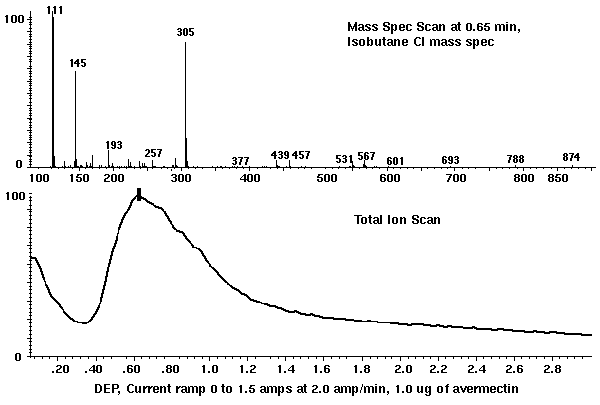
Figure 6 - DEP Analysis of Avermectin
Conclusions
A direct exposure probe (DEP) and current ramp controller were designed which allow the analysis of a wide range of compounds via direct introduction into the HP5989 mass spectrometer. The fast ramp rates achievable with this design minimized the thermal decomposition of the samples analyzed and permit the maximum sensitivity of analysis. Samples of sugars and a high molecular weight pesticide were analyzed with this probe which would have otherwise been impossible to accomplish with conventional DIP probe designs due to their temperature limitations as well as their limited ramp rate capabilities. Two different DEP filament tip designs were used, however minimal differences were observed for the samples analyzed. Additional probe tip designs can be easily tested with this probe due to the plug in design of the probe tip. Additional studies should be performed on the design of the probe tips. The impact of filament design on the analysis may be important for some samples in order to control the sensitivity of the sample analysis as well as the thermal decomposition or surface reactivity of the analyte with the filament tip.


